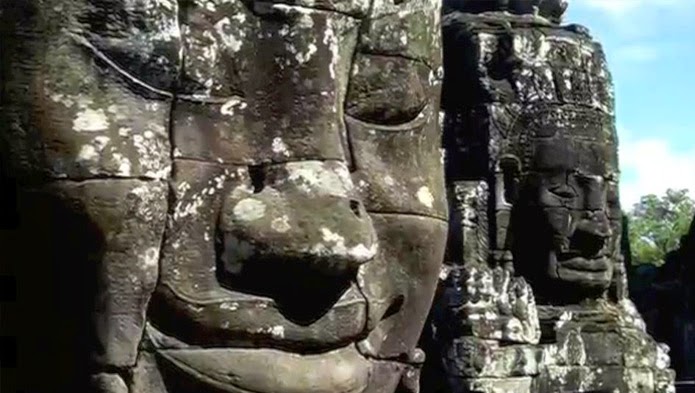Saint Peter´s Basilica is simbol of the force and the platform which, when the time again became ripe, would explode as the glorious centre of a rejuvenated Rome. By the third century, the Roman Empire had grown too big for its own good. Emperor Diocletian, aiming to make his cumbersome and restless dominions more manageable, divided the Empire into Eastern and Westem parts. The East was governed from Constantinople and the West from Ravenna, and then Milan. No longer the political focus of the Mediterranean and the conquered European world, the splendid city of Rome went into decline. However, before the Western Empire fell apart, two developments ensured that through its dark years, Rome's light would diminish but not extinguish. One was the establishment of the papacy. The second was the Basilica erected by Emperor Constantine, that great saviour of the Christians, over St Peter's grave.
In front of Saint Peter's Basillica you´ll find the statues of Saint Peter...
and Saint Paul, with Jesus on the topPeter, considered first amongst Christ's twelve apostles, was crucified and buried in Rome in 61 CE. He was the founder of Christianity in Rome. The Pope is recognized as his successor, as well as the Vicar of Christ and the worldwide spiritual head of the Roman Catholic Church. As Rome struggled through its difficult years, the papacy floundered but held itself together. By the eighth century, the legacy of the Western Roman Empire had been appropriated by a federation of central European states going by the nomenclature of the Holy Roman Empire.
Unified by Latin Christianity, the Empire beheld the Pope as its spiritual head. Nevertheless, despite being protected by the Holy Roman Emperors, the papacy remained insecure. By the fifteenth century, however, it had recharged and consolidated its resources. The Church was now plump with wealth, and its custodians, the popes, were itching to reassert their religion's and their own domimince. The Renaissance had begun in Italy. Rome's time had come again.
More than 1100 years into its first incarnation by now, St Peter's Basilica was not in the best of shape. Pope Nicholas V decided to something about it. From the time he began the demolition of the old building in 1452 to the consecration of the new building in 1626, eighteen popes blessed and witnessed the project. More importantly, virtually the who's who of the Renaissance's Creative line-up, as well as many Mannerist and Baroque virtuosos, contributed to it. The result was awesome.
The first impression of the Basilica - since 1929, a part of the independent Vatican state, within Rome - is of the enormity of its scale. The arrow straight road from the teeming city breaks into a massive piazza enclosed with semi - circular Doric colonnades designed by the Baroque architect Giovanni Bernini.

From the centre of the enormous space rises an Egyptian obelisk, first brought to Rome by Emperor Caligula in the first century, and raised here in the sixteenth century in complete silence, as a symbol of Christianity's victory over pagan faiths. The cross at its pinnacle is said to contain the relics of Christ's True Cross. The fifty-metre-high palatial façade of the Basilica is propped up by Corinthian columns. Again in Baroque style, Carlo Maderno's design is perfect for the Pope to stand at the balcony and bless the thronging crowds below. Past the main entrance into the Basilica is the Porta Santa, or the Holy Door, which is traditionally kept walled up and opened personally by the Pope for the course of a designated Holy Year. A window in the apse lights up an image of the Holy Spirit as a dove.

Dominating the nave is Bernini's ornamental baldacchino of gilded bronze. It covers the main altar at which only the Pope can celebrate Mass. Underneath it is St Peter's subterranean crypt, from which two-and-a-half hectares of magnificence radiates.Some way off from the Basilica, on Janiculum hillside, is the site of St. Peter's crucifixion. In the early sixteenth century, Donato Bramante designed the Tempietto San Pietro here. Displaying all the elements of classical antiquity, the Tempietto is considered Rome's first true Renaissance building. Its drum, dome and Dark columns served as the prototypal essence of the Basilica's central plan, for which Bramantc was commissioned by Pope Julius II. He was succeeded by another Renaissance giant, Raphael, much of whose handiwork was later altered. However, the creative instinct behind the Basilica's masterpiece, its dome, was Michelangelo's.At the age of seventy - one, Michelangelo was persuaded to take over as chief architect of St Peter's. His conditions: he would work "for the love of the Saint", without payment, without interference and without accounting responsibilities. He probably got the deal he wanted, though his hemispherical design was changed to an ovoid shape due to structural concerns.
Almost 140 metres high, the dome gets its skeletal strength from sixteen externally visible radial ribs. One can climb up to the base of the lantern for a sweeping view of the symmetrical piazza.
The inner shell looms over the baldacchino. Embellished with scores of frescoes, its curvature soars up to a bright climax. Medallions of saints are ranged around the base. Around it, in letters two metres high, are words from the Gospel of Matthew. They recall of the true reason for the sumptuous art and grandeur all around: "Thou art Peter, and upon this rock I will build my Church... I will give you the keys to the Kingdom of Heaven..." The Keys are below, carved on the base of the altar canopy, as part of Pope Urban VIII's coat of arms.



















































0 comments: